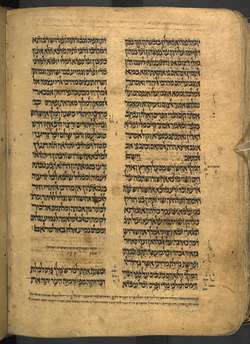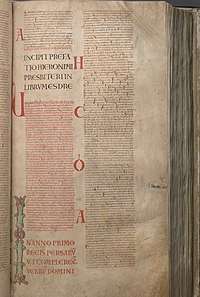Ezra 2
Ezra 2 is the second chapter of the Book of Ezra in the Old Testament of the Christian Bible,[1] or the book of Ezra-Nehemiah in the Hebrew Bible, which treats the book of Ezra and book of Nehemiah as one book.[2] Jewish tradition states that Ezra is the author of Ezra-Nehemiah as well as the Book of Chronicles,[3] but modern scholars generally accept that a compiler from the 5th century BCE (the so-called "Chronicler") is the final author of these books.[4] The section comprising chapter 1 to 6 describes the history before the arrival of Ezra in the land of Judah [5][6] in 468 BCE.[7] This chapter contains a list, known as the "Golah List",[8] of the people who returned from Babylon to Judah following Cyrus's edict "by genealogy, family and place of habitation".[5]
| Ezra 2 | |
|---|---|
 | |
| Book | Book of Ezra |
| Category | Ketuvim |
| Christian Bible part | Old Testament |
| Order in the Christian part | 15 |
Text

The original text is written in Hebrew language. This chapter is divided into 70 verses.
Textual witnesses
Some early manuscripts containing the text of this chapter in Hebrew are of the Masoretic Text, which includes Codex Leningradensis (1008).[9][lower-alpha 1]
There is also a translation into Koine Greek known as the Septuagint, made in the last few centuries BCE. Extant ancient manuscripts of the Septuagint version include Codex Vaticanus (B; B; 4th century), and Codex Alexandrinus (A; A; 5th century).[11][lower-alpha 2]
An ancient Greek book called 1 Esdras (Greek: Ἔσδρας Αʹ) containing some parts of 2 Chronicles, Ezra and Nehemiah is included in most editions of the Septuagint and is placed before the single book of Ezra–Nehemiah (which is titled in Greek: Ἔσδρας Βʹ). 1 Esdras 5:7-46 is an equivalent of Ezra 2 (List of former exiles who returned).[15][16]
The Community (2:1–63)

The list here is not an account the people who were recently back from the journey, but those who have arrived and settled down after returning from Babylon, where they currently reside in Palestine among the other inhabitants of the land – non-Jews and also the Jews who never left the land, "whom the Babylonians has left behind as undesirable".[17] The genealogies apparently "function as authenticators of who has a right to be classified as an Israelite", because "those who could not prove their genealogy were excluded" (verses 59–63).[5]
Verse 1
- Now these are the children of the province, who went up out of the captivity of those who had been carried away, whom Nebuchadnezzar the king of Babylon had carried away to Babylon, and who returned to Jerusalem and Judah, everyone to his city;[18]
Verse 2
- Those who came with Zerubbabel were Jeshua, Nehemiah, Seraiah, Reelaiah, Mordecai, Bilshan, Mispar, Bigvai, Rehum, and Baanah.
- The number of the men of the people of Israel:[22]
- "Zerubbabel": is the leader of the group and of Davidic line (1 Chronicles 3:19), so he is associated with the messianic hope in the book of Zechariah, although none of it is mentioned in this book.[23]
- Some names are written differently in the book of Nehemiah:[24]
Ezra 2:2 Nehemiah 7:7 Seraiah Azariah Reelaiah Raamiah Mispar Mispereth Rehum Nehum
- "Men of the people of Israel": The list makes the point that only those of the Gola (="the exiles") 'properly constituted "Israel"'.[21]
The Totals (2:64–67)
The number of the people here shows the depletion of the population; in time of Moses "the whole number of the people of Israel...from 20 years old and upward,... was 603,550" (Numbers 1:45–46) not counting the Levites, whereas in the time of David, "in Israel there were 800,000 valiant men who drew the sword, and the men of Judah were 500,000" (2 Samuel 24:9), but now the returned exiles, including the priests and Levites, only "amount to 42,360" (verse 64).[25] The listing of servants and animals reflects "the status of the exiles, their resources and capabilities".[26]
Temple Gifts (2:68–69)
Those arrived back in Jerusalem and Judah gave freewill offerings "toward the rebuilding of the house of God".[27]
Resettlement (2:70)
The conclusion of the list is similar to the beginning (verse 1): "by affirming the resettlement of the exiles", as every person has now settled "in their own towns".[27]
Notes
- Since 1947 the current text of Aleppo Codex is missing the whole book of Ezra-Nehemiah.[10]
- The extant Codex Sinaiticus only contains Ezra 9:9–10:44.[12][13][14]
References
- Halley 1965, p. 232.
- Grabbe 2003, p. 313.
- Babylonian Talmud Baba Bathra 15a, apud Fensham 1982, p. 2
- Fensham 1982, pp. 2–4.
- Grabbe 2003, p. 314.
- Fensham 1982, p. 4.
- Davies, G. I., Introduction to the Pentateuch in Barton, J. and Muddiman, J. (2001), The Oxford Bible Commentary, p. 19
- Smith-Christopher 2007, p. 311.
- Würthwein 1995, pp. 36-37.
- P. W. Skehan (2003), "BIBLE (TEXTS)", New Catholic Encyclopedia, 2 (2nd ed.), Gale, pp. 355–362
- Würthwein 1995, pp. 73-74.
- Würthwein, Ernst (1988). Der Text des Alten Testaments (2nd ed.). Stuttgart: Deutsche Bibelgesellschaft. p. 85. ISBN 3-438-06006-X.
- Swete, Henry Barclay (1902). An Introduction to the Old Testament in Greek. Cambridge: Macmillan and Co. pp. 129–130.
-

- Catholic Encyclopedia: Esdras: THE BOOKS OF ESDRAS: III Esdras
- Jewish Encyclopedia: Esdras, Books of: I Esdras
- Larson, Dahlen & Anders 2005, p. 18.
- Ezra 2:1 WEB
- Fensham 1982, p. 48.
- Hebrew Text Analysis: Ezra 2:1. Biblehub
- McConville 1985, p. 15.
- Ezra 2:2 NKJV
- McConville 1985, p. 14.
- Notes [a], [b], [c], [d] on Ezra 2:2 in NKJV
- Levering 2007, pp. 47–48.
- Larson, Dahlen & Anders 2005, p. 23.
- Larson, Dahlen & Anders 2005, p. 24.
Sources
- Fensham, F. Charles (1982). The Books of Ezra and Nehemiah. New international commentary on the Old Testament (illustrated ed.). Wm. B. Eerdmans Publishing. ISBN 978-0802825278. Retrieved October 28, 2019.
- Grabbe, Lester L. (2003). "Ezra". In Dunn, James D. G.; Rogerson, John William (eds.). Eerdmans Commentary on the Bible (illustrated ed.). Wm. B. Eerdmans Publishing. pp. 313–319. ISBN 978-0802837110. Retrieved October 28, 2019.
- Halley, Henry H. (1965). Halley's Bible Handbook: an abbreviated Bible commentary (24th (revised) ed.). Zondervan Publishing House. ISBN 0-310-25720-4.
- Larson, Knute; Dahlen, Kathy; Anders, Max E. (2005). Anders, Max E. (ed.). Holman Old Testament Commentary - Ezra, Nehemiah, Esther. Holman Old Testament commentary. Volume 9 (illustrated ed.). B&H Publishing Group. ISBN 978-0805494693. Retrieved October 28, 2019.
- Levering, Matthew (2007). Ezra & Nehemiah. Brazos Theological Commentary on the Bible. Brazos Press. ISBN 978-1587431616. Retrieved October 28, 2019.
- McConville, J. G. (1985). Ezra, Nehemiah, and Esther. The daily study Bible : Old Testament. Westminster John Knox Press. ISBN 978-0664245832. Retrieved October 28, 2019.
- Smith-Christopher, Daniel L. (2007). "15. Ezra-Nehemiah". In Barton, John; Muddiman, John (eds.). The Oxford Bible Commentary (first (paperback) ed.). Oxford University Press. pp. 308–324. ISBN 978-0199277186. Retrieved February 6, 2019.
- Würthwein, Ernst (1995). The Text of the Old Testament. Translated by Rhodes, Erroll F. Grand Rapids, MI: Wm. B. Eerdmans. ISBN 0-8028-0788-7. Retrieved January 26, 2019.
External links
- Jewish translations:
- Ezra - Chapter 2 (Judaica Press) translation [with Rashi's commentary] at Chabad.org
- Christian translations:
- Online Bible at GospelHall.org (ESV, KJV, Darby, American Standard Version, Bible in Basic English)
- Book of Ezra Chapter 2. Bible Gateway